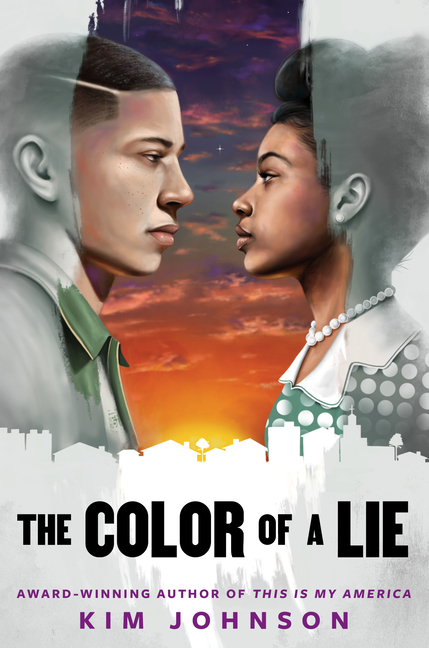
Book Resume
for The Color of a Lie by Kim Johnson
Professional book information and credentials for The Color of a Lie.
5 Professional Reviews (1 Starred)
2 Book Awards
Selected for 2 State/Province Lists
See full Book Resume
on TeachingBooks
- Booklist:
- Grades 9 - 12
- Kirkus:
- Ages 12 and up
- Publisher's Weekly:
- Ages 12 and up
- TeachingBooks:*
- Grades 7-12
- Lexile Level:
- 600L
- Cultural Experience:
- African American
- Genre:
- Historical Fiction
- Year Published:
- 2024
5 Subject Headings
The following 5 subject headings were determined by the U.S. Library of Congress and the Book Industry Study Group (BISAC) to reveal themes from the content of this book (The Color of a Lie).
5 Full Professional Reviews (1 Starred)
The following unabridged reviews are made available under license from their respective rights holders and publishers. Reviews may be used for educational purposes consistent with the fair use doctrine in your jurisdiction, and may not be reproduced or repurposed without permission from the rights holders.
Note: This section may include reviews for related titles (e.g., same author, series, or related edition).
From Horn Book
July 1, 2024
Moving to a new town can prove stressful for anyone -- but for Calvin Greene and his family in 1955, it's also dangerous. African Americans passing for white, the Greene family has moved to Levittown, Pennsylvania, a known "sundown town" -- a suburb populated by white people that warns people of color to leave the area by sunset. Determined to grab a piece of the "American dream," Calvin's army-veteran father has advised him and his mother to forget their former lives in Chicago and assimilate as well as possible. Calvin's only solace is visiting his older brother, who is unable to pass as white and who runs a boarding school in an area where a developer is attempting to build an integrated community. At the school, Calvin meets Lily, a beautiful girl with "dark brown skin" who decides to take advantage of the new Brown v. Board of Education ruling by attending Calvin's all-white school. With his two worlds dangerously close to each other, tragedies involving people from his hometown prompt Calvin to act in the best interests of all those close to him -- even if it could cost him his life. Tension is evident from the beginning to the frenetic end of this page-turning novel, which weaves historical events into the narrative. Back matter includes an author's note and resources on topics including passing, the history of Levittown, and redlining. Eboni Njoku
(Copyright 2024 by The Horn Book, Incorporated, Boston. All rights reserved.)
From Booklist
May 15, 2024
Grades 9-12 It's 1955 when Calvin and his parents settle in an all-white neighborhood in Levittown, Pennsylvania, leaving behind a terrible tragedy in their old home in Chicago. They are Black but can ""pass."" Calvin has done it before for short stints; now he has to do it all day, every day. As he gets to know other teens in the neighborhood and at school, he's appalled at their attitudes. Then he falls for Lily, a Black girl who tries to integrate the high school, and he is torn. Calvin's reactions to events such as Emmett Till's murder and the way Lily is treated by both students and teachers are highly charged, creating suspicion in the other students. Soon, though, he's drawn into the civil rights movement and takes a stand. Calvin is likable, desperately wanting to do the right thing. Lily is a particularly strong character, and she balances out Calvin's emotionality. This is a solid portrait of a shameful time in U.S. history as well as a dynamic narrative portraying its impacts on everyday people.
COPYRIGHT(2024) Booklist, ALL RIGHTS RESERVED.
From Kirkus
April 1, 2024
In Pennsylvania in 1955, an African American family passes for white in order to move into a segregated community. Calvin Greene has experienced passing for short periods, but now his father has purchased a home in a restricted community, and everything depends upon their being accepted as white. For those allowed to live there, Levittown is the American dream, but Calvin can only think about what he's leaving behind in Chicago. The one thing he's looking forward to is seeing his brother, Robert, who's estranged from their father and runs a small Black boarding school nearby. When Lily Baker, one of Robert's students, integrates Calvin's high school, Calvin finds himself caught between two worlds as never before. White community leaders are fiercely determined to maintain an all-white environment, and once Calvin starts a part-time job at a real estate firm, he learns how far they'll go. Meanwhile, the Civil Rights Movement is gaining momentum, and he wants to be part of that change. The tension Calvin experiences is palpable in this highly detailed depiction of post-World War II Black life. From specifics around hair and skin to the constant threat of racial violence, Johnson captures the tenor and tone of the times by weaving historical events and strong characterization into her taut narrative. A highly effective story of a young man's journey in a time simmering with racial change and resistance. (author's note, resources) (Historical fiction. 12-18)
COPYRIGHT(2024) Kirkus Reviews, ALL RIGHTS RESERVED.
From Publisher's Weekly
Starred review from March 11, 2024
In 1955, Black 17-year-old Calvin Green and his family are forced to leave Chicago for Levittown, Pa., a sundown town. His father encourages them to present themselves as white by disassociating from anything rooted in Black culture. For Calvin, that means no listening to jazz or playing his beloved trumpet. Calvin's queer, community-organizing older brother Robert-who can't pass like Calvin and their parents-lives across town and runs Sojourner, a boardinghouse devoted to supporting Black kids. As Calvin works to blend in, he's torn between guilt about lying, the feeling that he's abandoning his brother, and his desire to stay true to his Black identity. When he witnesses Black new student Lily being mistreated by his white peers, he uses his passing privilege to defend her, setting him on a path toward liberating other Black youth. But as he delves into the history of his new town, emerging secrets might make his mission more difficult-and dangerous-than he anticipated. Social issues surrounding redlining and white flight serve as a backdrop to this searing work. Through Calvin's perceptive and sincere first-person narration, Johnson (Invisible Son) examines the complexities of passing privilege and highlights the extreme lengths that those in power will go to uphold white supremacy. Ages 12â€"up. Agent: Jennifer March Soloway, Andrea Brown Literary.
From AudioFile Magazine
Golden Voice Kevin R. Free portrays Calvin Greene's mix of paranoia and anger when his African American family demands that he pass as white in a segregated Pennsylvania community in 1955. Free expresses the longing Kevin feels for his sister, who was killed by racial violence. While pretending to be a white person, he also misses his best friend, his estranged brother, and playing jazz. Free depicts how Calvin's quiet disgust for the spoiled white students he attends school with turns to animosity and then to fierce protection of Lily, a new student who is integrating the school. As his feelings for Lily become stronger, so does Free's voicing of Calvin's belief in the developing Civil Rights movement. He contrasts Calvin's good judgment with the wrongness of his father's decisions and the racist community that surrounds them both. S.W. © AudioFile 2024, Portland, Maine
2 Book Awards & Distinctions
The Color of a Lie was recognized by committees of professional librarians and educators for the following book awards and distinctions.
2 Selections for State & Provincial Recommended Reading Lists
The Color of a Lie was selected by educational and library professionals to be included on the following state/provincial reading lists.
United States Lists (2)
Preview Digital Book
Explore The Color of a Lie on Marketplace. Access requires OverDrive Marketplace login.
This Book Resume for The Color of a Lie is compiled from TeachingBooks, a library of professional resources about children's and young adult books. This page may be shared for educational purposes and must include copyright information. Reviews are made available under license from their respective rights holders and publishers.
*Grade levels are determined by certified librarians utilizing editorial reviews and additional materials. Relevant age ranges vary depending on the learner, the setting, and the intended purpose of a book.
Retrieved from TeachingBooks on January 19, 2025. © 2001-2025 TeachingBooks.net, LLC. All rights reserved by rights holders.


 Junior Library Guild Selections, 2012-2024, History Selection, 2024
Junior Library Guild Selections, 2012-2024, History Selection, 2024
 SLJ Best Books of the Year, 2010 - 2024, Selection, 2024
SLJ Best Books of the Year, 2010 - 2024, Selection, 2024
